MARIANI’S
Virtual
Gourmet
April 10, 2016
NEWSLETTER
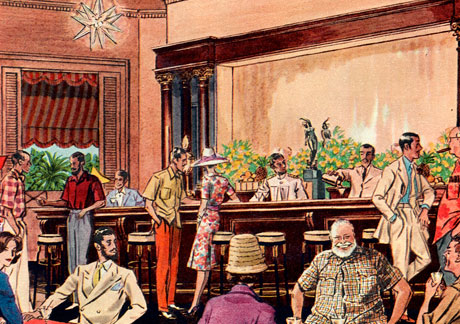
"Hemingway
at La Floridita, Havana" by Leslie Saalburg
IN THIS ISSUE
DINING OUT IN LOUISVILLE
By John Mariani
NEW YORK CORNER
BENOIT
By John Mariani
NOTES FROM THE WINE CELLAR
ALEXANDER VALLEY
By Geoff Kalish
❖❖❖

AN ANNOUNCEMENT: On Wednesday April 13 at 7
PM at the Westchester Italian Cultural Center in
Tuckahoe, NY, John Mariani will give a convivial
talk on "The
Enduring Presence of Mamma in the Italian
Kitchen." A light reception is offered
prior to the beginning of the presentation from
6:30-7 PM. Members: $20, non-members $25. For
details click here: www.wiccny.org
❖❖❖
DINING OUT IN LOUISVILLE
By John Mariani
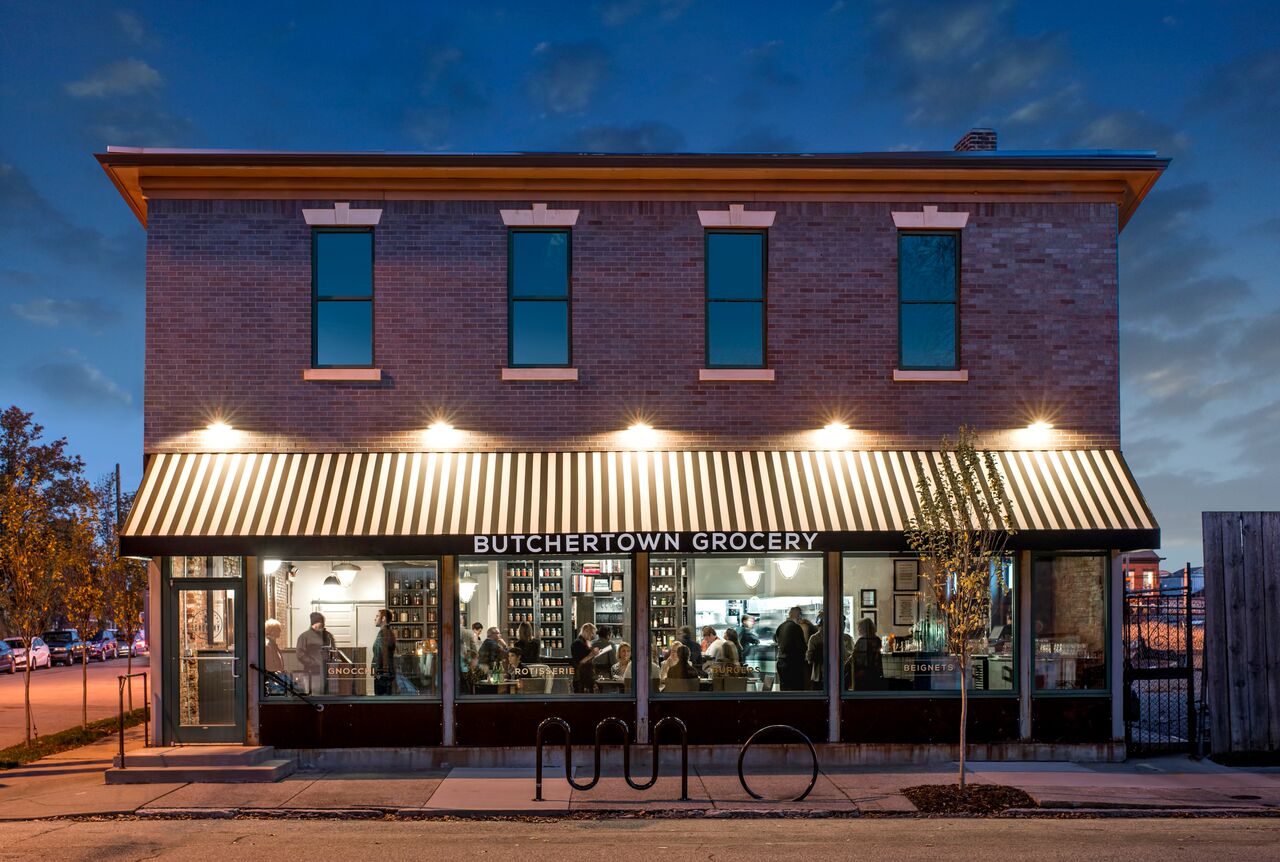
Louisville
has always had a commendable number of restaurants
of every stripe, from the one-of-a-kind Seviche
to the modern Proof on Main,
from the wonderfully old-fashioned Pat’s
Steakhouse
for the fried chicken and T-bone to The Brown Hotel,
where the Hot Brown sandwich was invented. But on
a recent visit it became clear that Louisville’s
restaurant scene has expanded to join the quantity
and quality of those mid-South cities like
Nashville and Charleston. Young
chefs, new neighborhoods and a demand for
first-rate ingredients has brought life back
downtown and in the city’s residential
neighborhoods.
Here’s where I ate happily.
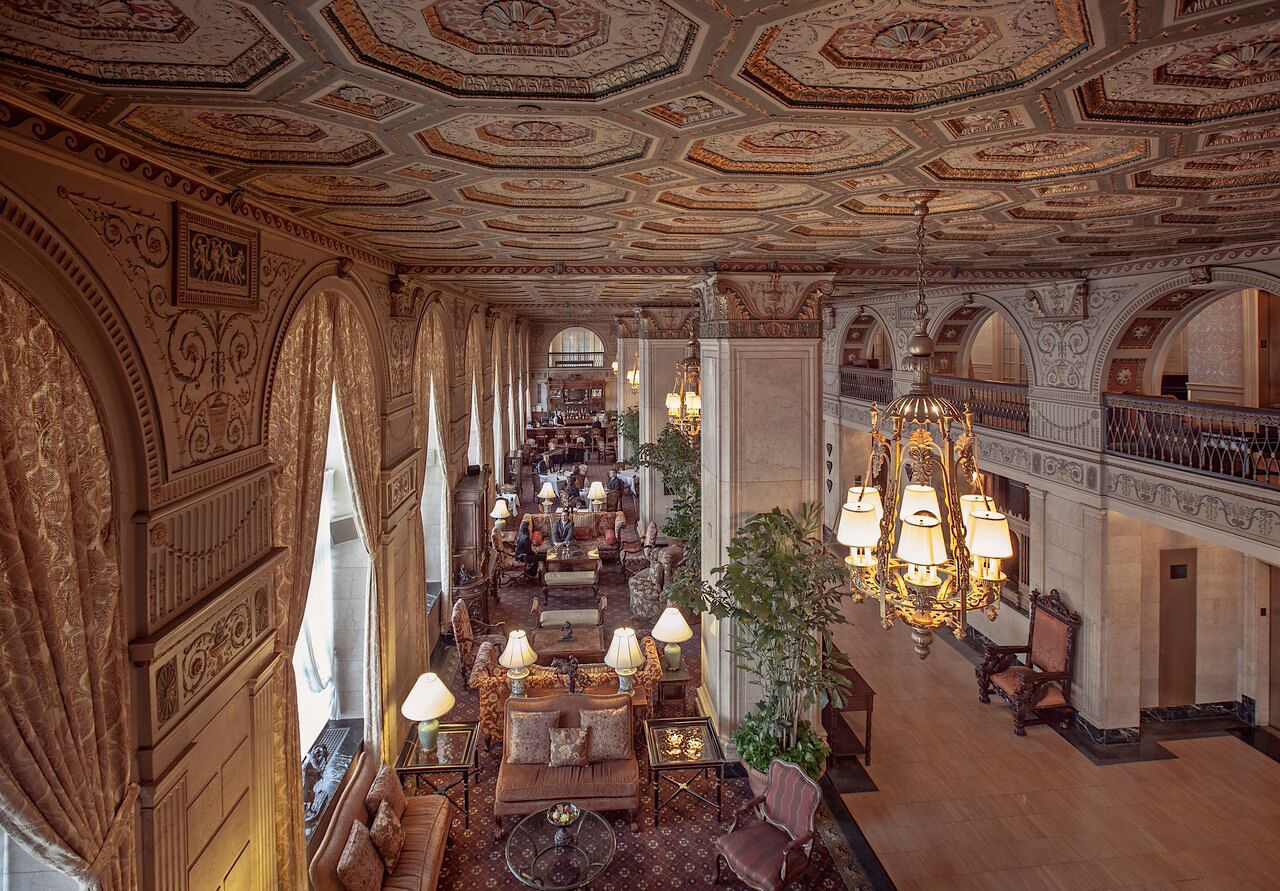 THE ENGLISH GRILL
THE ENGLISH GRILL
The Brown Hotel
335 West Broadway
877-926-7757
brownhotel.com
It’s also relaxingly quiet for a
big city downtown hotel. And for all that, The Brown
still is home to Louisville’s finest restaurant, The
English Grill (below),
whose dark oak paneling, lead glass windows, tracery
ceilings and equestrian paintings transcend being
merely historic by virtue of their polished beauty,
with a cordial service staff to match. Executive
Chef Joshua Bettis, who’s worked everywhere from
Killarney Park 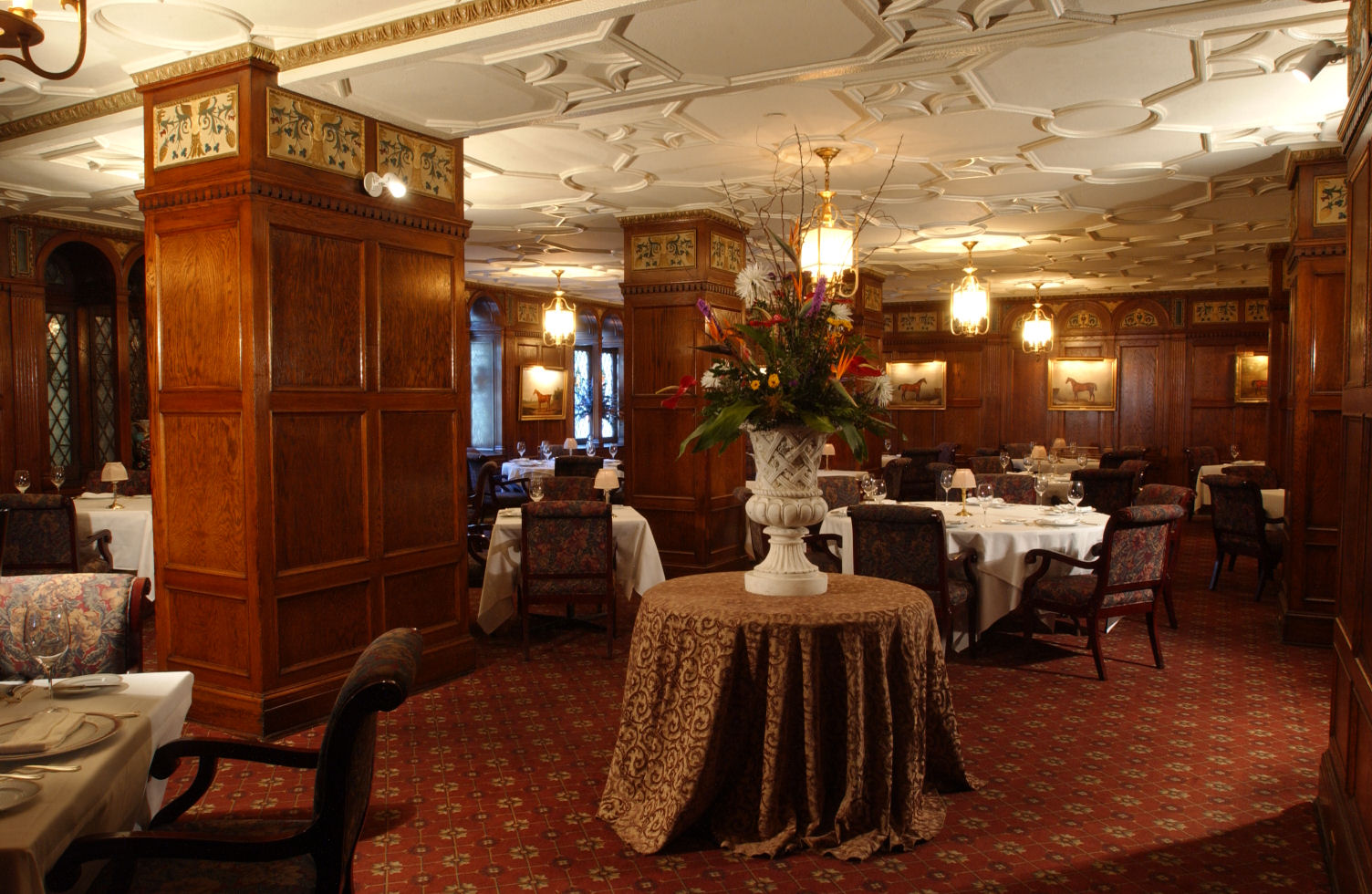 Hotel in
Ireland to Montelucia Resort in Paradise Valley,
focuses as much as possible on Kentucky resources
but readily seeks out the best he can find anywhere. Thus, he
gets beautiful sea scallops, which he serves with a
sunny side-up quail egg and rich Béarnaise,
“Benedict style,” along with lamb bacon ($14). There’s a
crab cake on the menu, good and meaty and with
minimum binder, served with creamy celeriac
remoulade ($13).
A classic Caesar salad ($11) is dexterously
prepared tableside, an artful display I always
welcome.
Hotel in
Ireland to Montelucia Resort in Paradise Valley,
focuses as much as possible on Kentucky resources
but readily seeks out the best he can find anywhere. Thus, he
gets beautiful sea scallops, which he serves with a
sunny side-up quail egg and rich Béarnaise,
“Benedict style,” along with lamb bacon ($14). There’s a
crab cake on the menu, good and meaty and with
minimum binder, served with creamy celeriac
remoulade ($13).
A classic Caesar salad ($11) is dexterously
prepared tableside, an artful display I always
welcome.
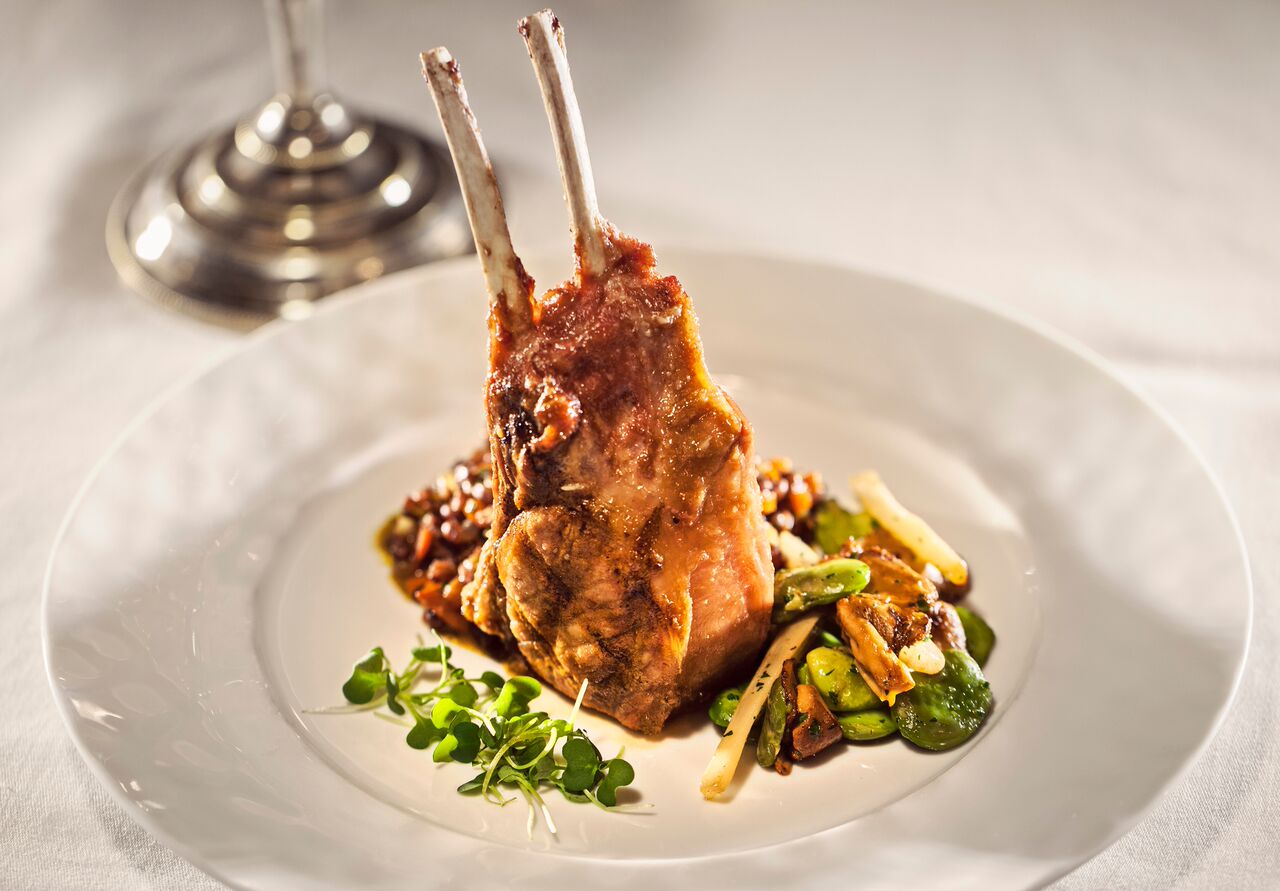 Bettis
also does another old-fashioned dish, lobster
Thermidor, abundant with lobster meat removed from
the shell and lavished with cream and a touch of
sherry ($52). The trick with this dish is to not
overcook the lobster or overpower it, and Bettis’s
version is as fine as any I’ve had over the decades.
Bettis
also does another old-fashioned dish, lobster
Thermidor, abundant with lobster meat removed from
the shell and lavished with cream and a touch of
sherry ($52). The trick with this dish is to not
overcook the lobster or overpower it, and Bettis’s
version is as fine as any I’ve had over the decades.
There’s Kentucky-raised
wagyu-style Angus filet ($54) I found far more bland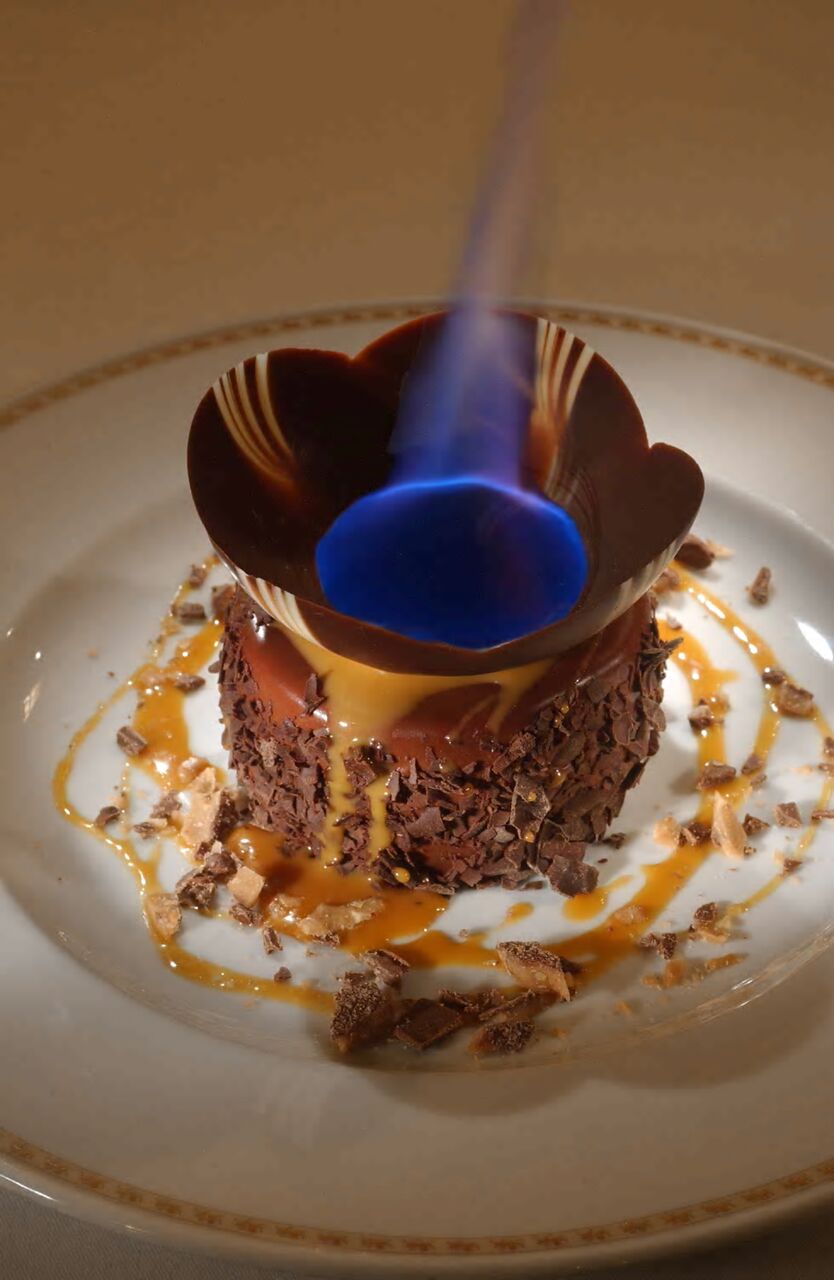 than I’d
expected, but the amount of flavor in a grilled
double-cut Kentucky pork chop ($36) was
extraordinary, showing why American pork can be
superlative when it retains its natural fat.
than I’d
expected, but the amount of flavor in a grilled
double-cut Kentucky pork chop ($36) was
extraordinary, showing why American pork can be
superlative when it retains its natural fat.
For dessert there is a spiced
brioche rum pudding ($10), but don’t hesitate on
choosing the signature item here—“Chocolate
Striptease” (right)—whose
meaning eludes me but whose combination of milk
chocolate mousse, espresso steam cake, and salted
caramel, then flamed with Bacardi 151rum ($10) is as
much a hoot as it is a grand dessert.
The English Grill has one of the
city’s best wine cellars and, as you might hope, an
excellent selection of bourbons, including two
vintages of the celebrated (if over-rated) Pappy.
Too many
people save an evening at The English Grill for a
special occasion, for while it is very special
indeed, it is also a place to appreciate the true
and enduring genteel charms and hospitality of
Louisville at
its finest.
Open Mon.-Sat. for dinner.
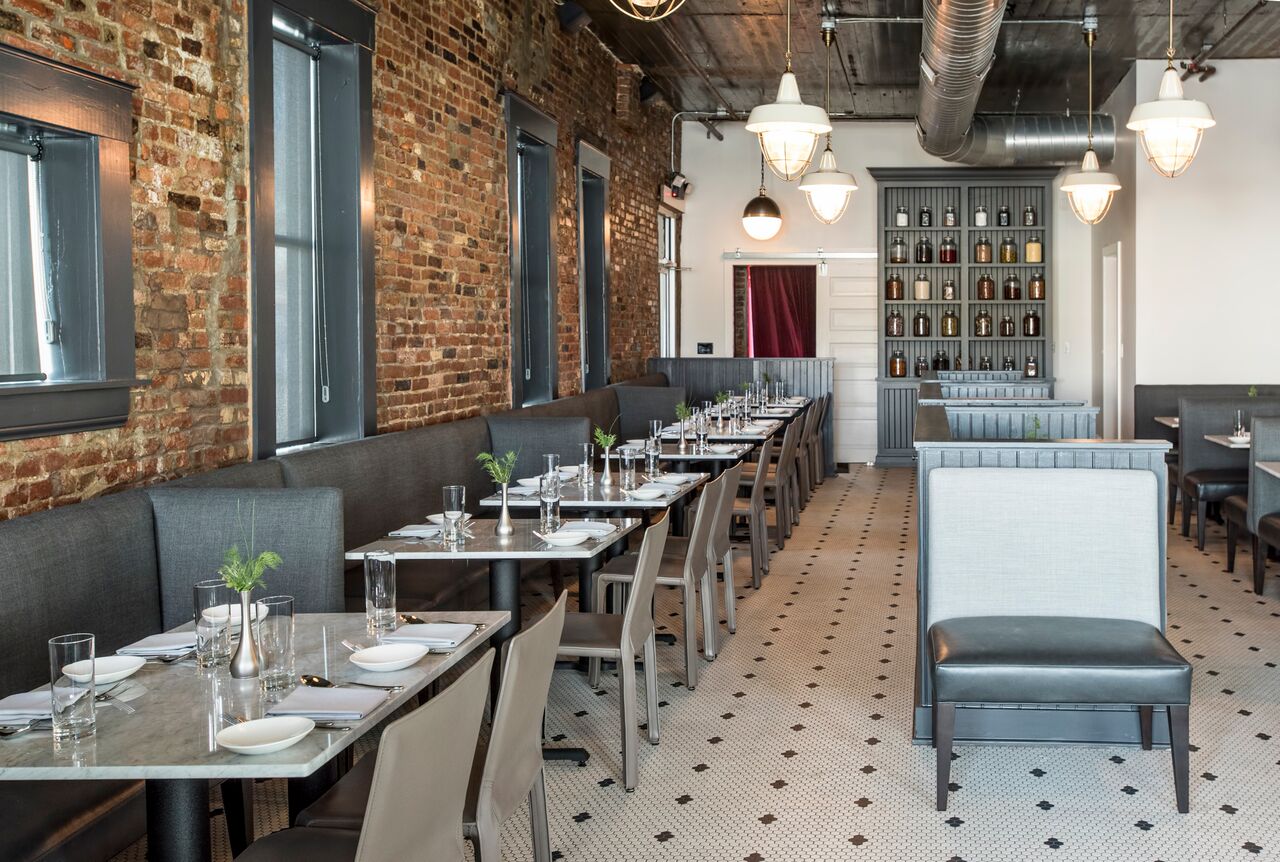 BUTCHERTOWN GROCERY
BUTCHERTOWN GROCERY
1076 E. Washington Street
502-742-8315
butchertowngrocery.com
The name derives from an old
grocery, dating to 1875, once called Gunkel’s, known as much as a
Louisville gathering place as a place to buy
provisions. As a new restaurant it is easily as
convivial, and its décor pays a rustic homage to the
space’s origins, with expanses of brick walls,
weathered exposed wood on the ceiling, marble
tables, and a tile floor, along with very
comfortable banquettes and a very popular bar up
front. It
does get loud with the sound of people enjoying
themselves immensely, not least upstairs in the
music lounge, and they could bring up the lighting a
bit.
Owners Jon Salomon, Patrick
Hallahan and chef Bobby Benjamin have managed to
keep a balance between casual surroundings and
serious food, and they’ve kept the wine list at very
decent price points, with about half the bottles
under $50.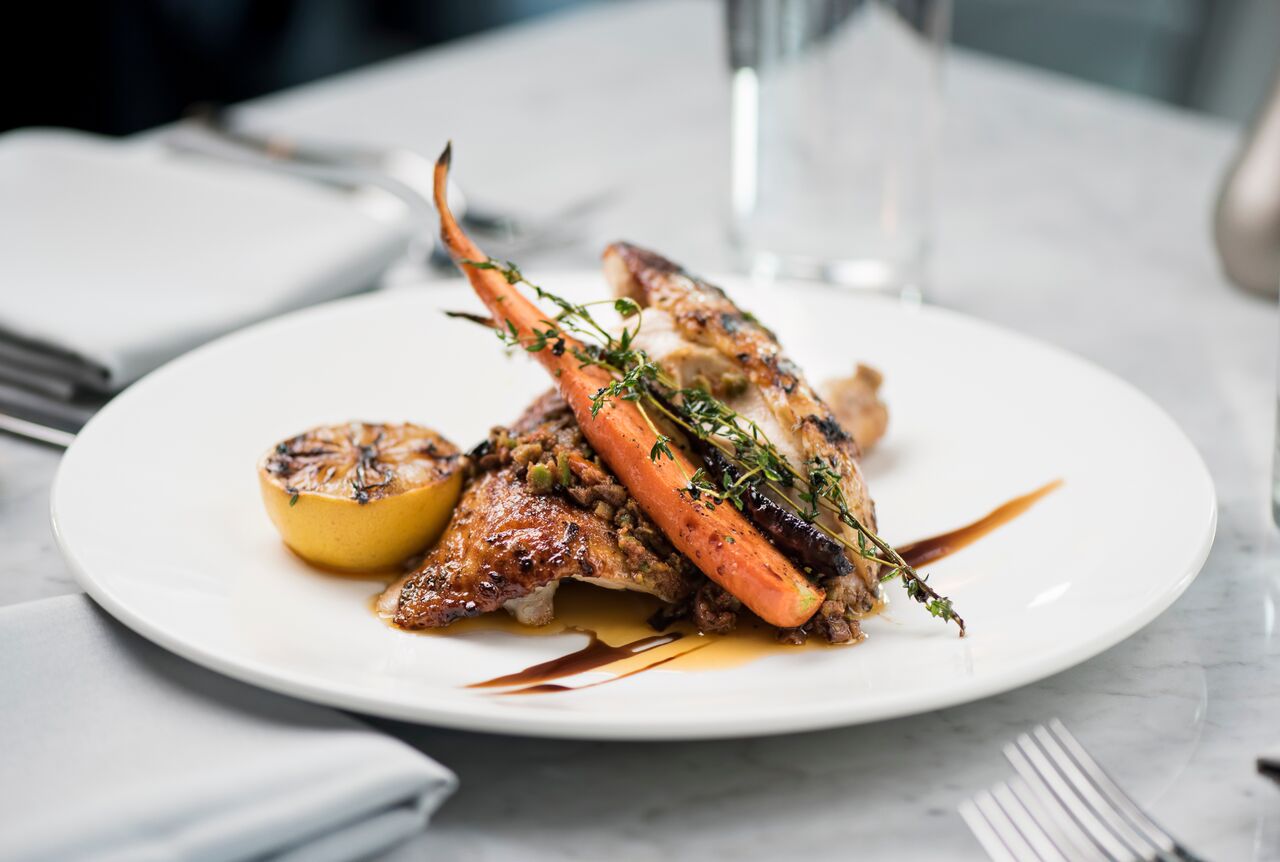
There are
the expected burgers and sandwiches ($14-$18) and
the trendiest of vegetables—a Brussels sprout salad
($10) and kale salad with beets ($9)—as well as two
very good pasta dishes—fettuccine with wild
mushrooms, bacon, goat’s cheese, a little lemon zest
and a judicious dusting of herbs ($14), and
first-rate, perfectly textured potato gnocchi with
mushrooms and parmigiano ($9 as a side dish).
Two of the
entrees I tried showed the kitchen’s adept timing
with cooking a beautiful rainbow trout (right) with
fregula, charred onions and peppers with creamy
avocado ($24), and sweet diver’s scallops with
parsnips, fried leeks, and a delicious orange butter
(below) to
bind it all together with a little sweet-and-tangy
counterpoint ($27).
Adding the flavor of white anchovies to an
otherwise well-cooked roast chicken ($28) was not,
however, Chef Benjamin’s best idea, unless you enjoy
chicken that tastes fishy and sour.
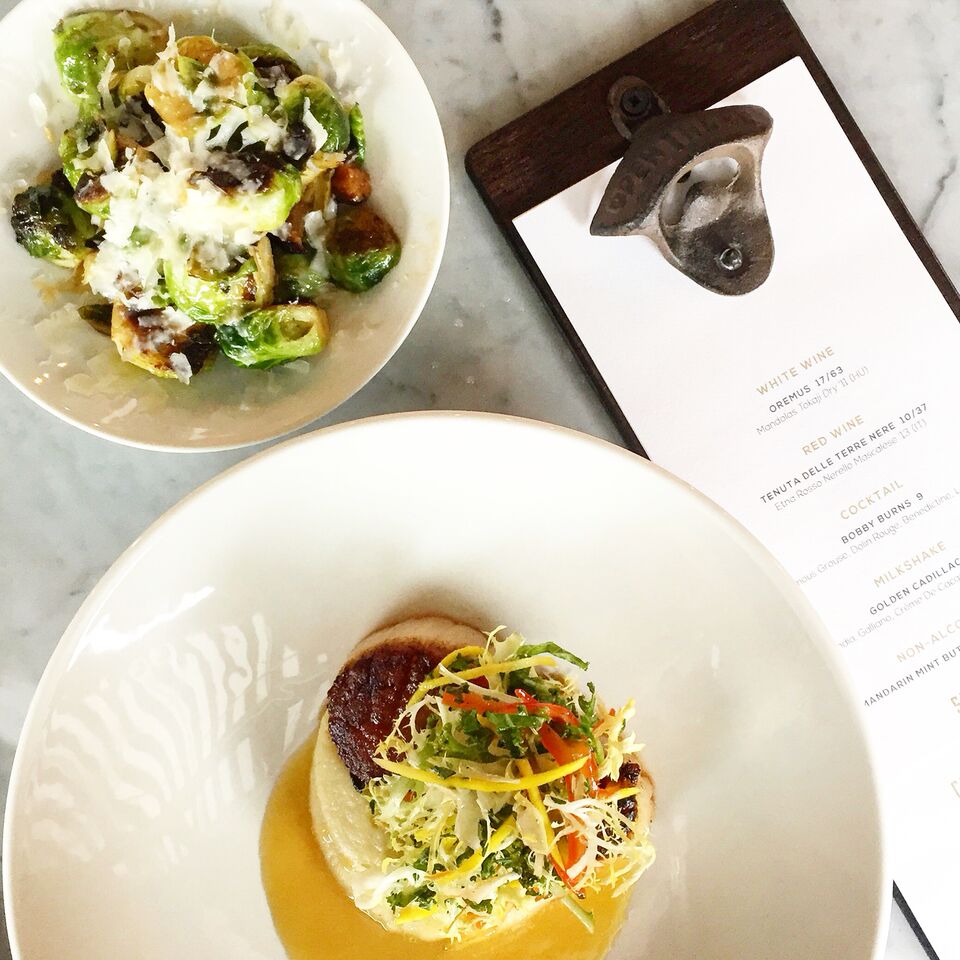 That night, at
least, hand-cut French fries ($6) were surprisingly
limp.
That night, at
least, hand-cut French fries ($6) were surprisingly
limp.
All the desserts are sumptuous, from a fine
cheesecake to a hefty but not too heavy bread
pudding and a juicy berry crumble—great endings with
which to enjoy a nightcap from the bar.
You can tell that the
owners of Butchertown Grocery had a distinct idea of
what kind of place it should be, which might well
have been a mess of clichés. But the
pieces all fit as they should and the place has
great charm and seriously good food and drinks. If you’re
visiting Louisville, people will surely tell you
about it.
Open Wed.-Sun. for dinner; Brunch
Sat. & Sun. Live jazz on Saturday.
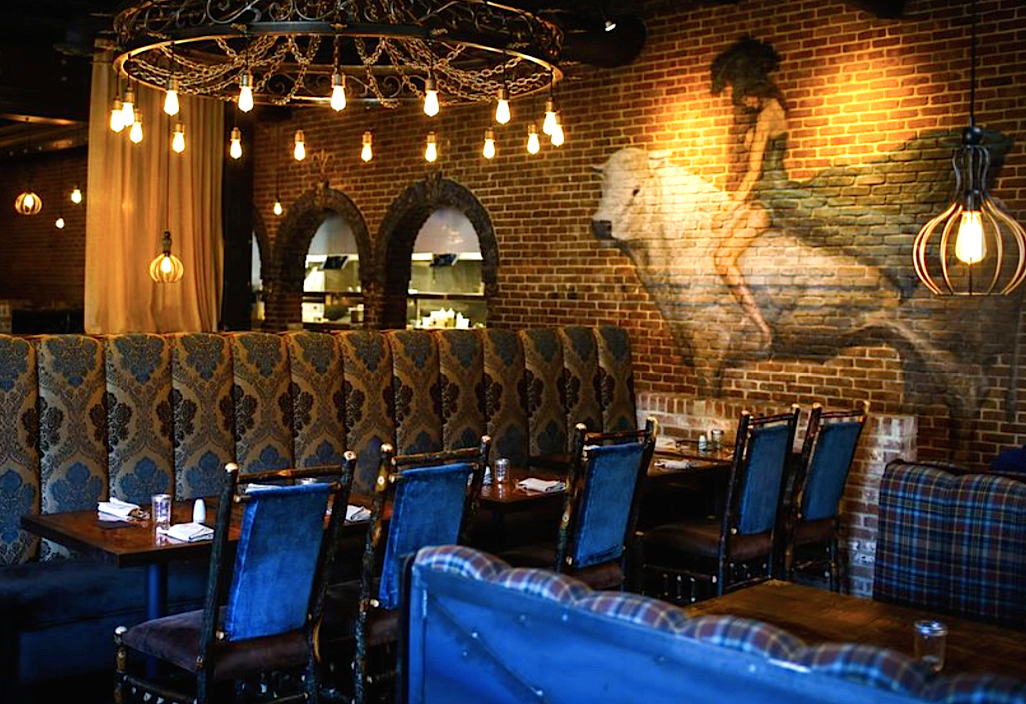
2300 Lexington Road
502-458-8888
lemoorestaurant.com
Le Moo, with a name that makes it sound
like a dairy bar or hipster cheese monger, is
actually a very big deal steakhouse in Louisville. Half Las
Vegas hype and half risqué French salon, it is all
designed to impress the hell out of you, and your
capacity for instant swank will determine just how
much fun you have.
Owner Kevin
Grangier, a branding and p.r. professional, had a
success in 2010 with The Village Anchor bistropub,
and he was determined to give his native city a
steakhouse that deviated from the decorous norm.
Replacing
a long-time restaurant favorite named KT’s, Le Moo
was gutted and transformed with huge chandeliers,
bordello-like draperies and secluded
tables—including a Louis Vuitton booth, all done up
in old luggage sheathing—and the requisite stuffed
Texas longhorn head above the entrance. The bar
offers 30 different cocktails and the wine cellar
stocks 1,200 bottles, with many labels under $50.
 The focus of
the menu here is on 14 different cuts of steak, all
arrayed behind a glass counter, including ribeyes
($39-$89), New York strips ($39-$96) and filets
($42-$78), available as Choice, Prime or dry-aged
bone-in. They
also list “Grade 8 Wagyu Prime” from an unnamed
American source, but I can’t find any reference to a
grade beyond “5” listed by the American Wagyu
Association.
The focus of
the menu here is on 14 different cuts of steak, all
arrayed behind a glass counter, including ribeyes
($39-$89), New York strips ($39-$96) and filets
($42-$78), available as Choice, Prime or dry-aged
bone-in. They
also list “Grade 8 Wagyu Prime” from an unnamed
American source, but I can’t find any reference to a
grade beyond “5” listed by the American Wagyu
Association.
These steaks come
with a choice of half a dozen sauces, or perhaps a
Maytag blue cheese crust, and three potato
renditions, including a huge stuffed baked Idaho,
layered with Parmesan and cheddar cheeses, smoked
bacon, butter, sour cream, and sea salt ($6)—one of
which could serve four people. If a potato can seem
magnanimous, this one surely is. There’s also
braised collard greens with country ham ($5).
The menu goes on a
while from there, from beef stroganoff with sour
cream ($22) to a vegan cassoulet ($17) and a whole
lot more.
So you go to Le Moo with expectations of good
steaks, but once you get there you become part of an
entertainment.
It’s said, “You can’t eat the furniture,” but
you can dine well while luxuriating on it at Le Moo.
Lunch Mon.-Fri., Brunch Sat. &
Sun., Dinner nightly.
BLUE DOG BAKERY AND CAFE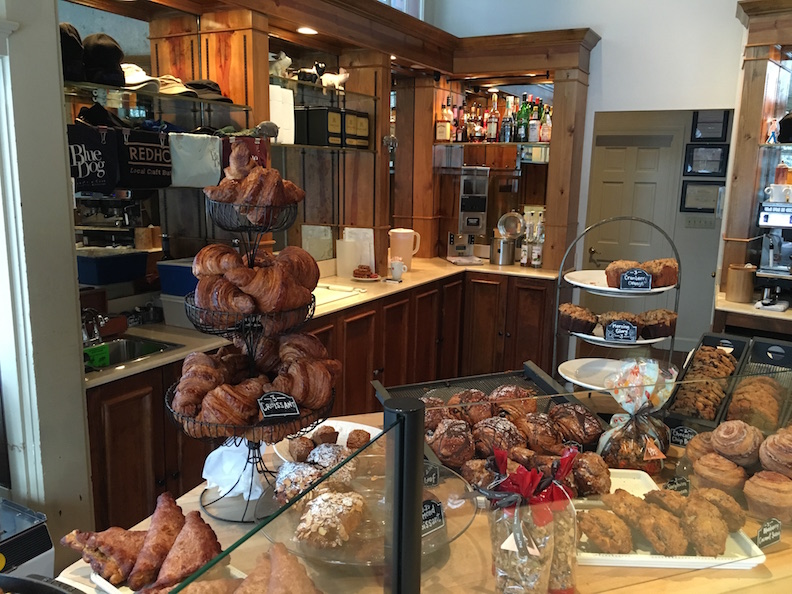
2868 Frankfort Avenue
502-899-9800
bluedogbakeryandcafe.com
The whole idea of a casual
breakfast or late afternoon sit-down to a pastry and
hot coffee must be the universal daydream of all who
rush through their lives fueled by coffee from a
dispenser and a donut. So the lovable Blue Dog Bakery
is where you go when you want to savor your take-out
pastries and coffee at home or at work or, better,
to bask for a while in the pleasures of going slow
on premises.
As their website states, “Artisan
breads are made to be eaten,” meaning that a loaf
that owners Bob Hancock and Kit Garretts and their
staff take two days to make right deserves to be
enjoyed when it’s ready, not the next day, which
seems obvious when you taste it. They list their
baking schedule, too: baguettes Tuesdays through
Saturday, brioche Friday and Saturday, cranberry
walnut on Saturdays, and much more. Of course, you
know right away they’re using the best local
ingredients, unbleached and organic flour, sourdough
and so on.
The front counter is
also piled high with big cookies, tarts, muffins and
scones, along with breakfast quiches and
house-made granola.
But
there’s much more to Blue Dog than just the city’s
best baked goods. For brunch you can have eggs on
levain bread with Serrano ham, spinach and Parmesan
($9); sandwiches like saltimbocca with Serrano ham,
chicken, smoked mozzarella and peperoncini ($9);
salads for lunch, and wonderful tartines and pizzas
on excellent crusts, including poached egg and bacon
pizza ($12) and a sardine tartine with Great Northern
bean puree, capers, scallion and chilies ($11).
Plan on taking your time at Blue
Dog. You’ll
want to linger.
Open Tues.-Sat.
❖❖❖
By John Mariani
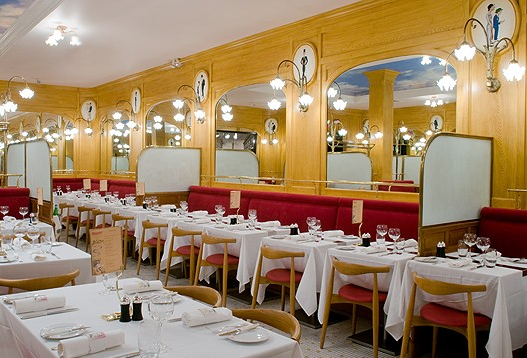
60 West 55th Street (near Avenue of the Americas)
646-943-7373
benoitny.com
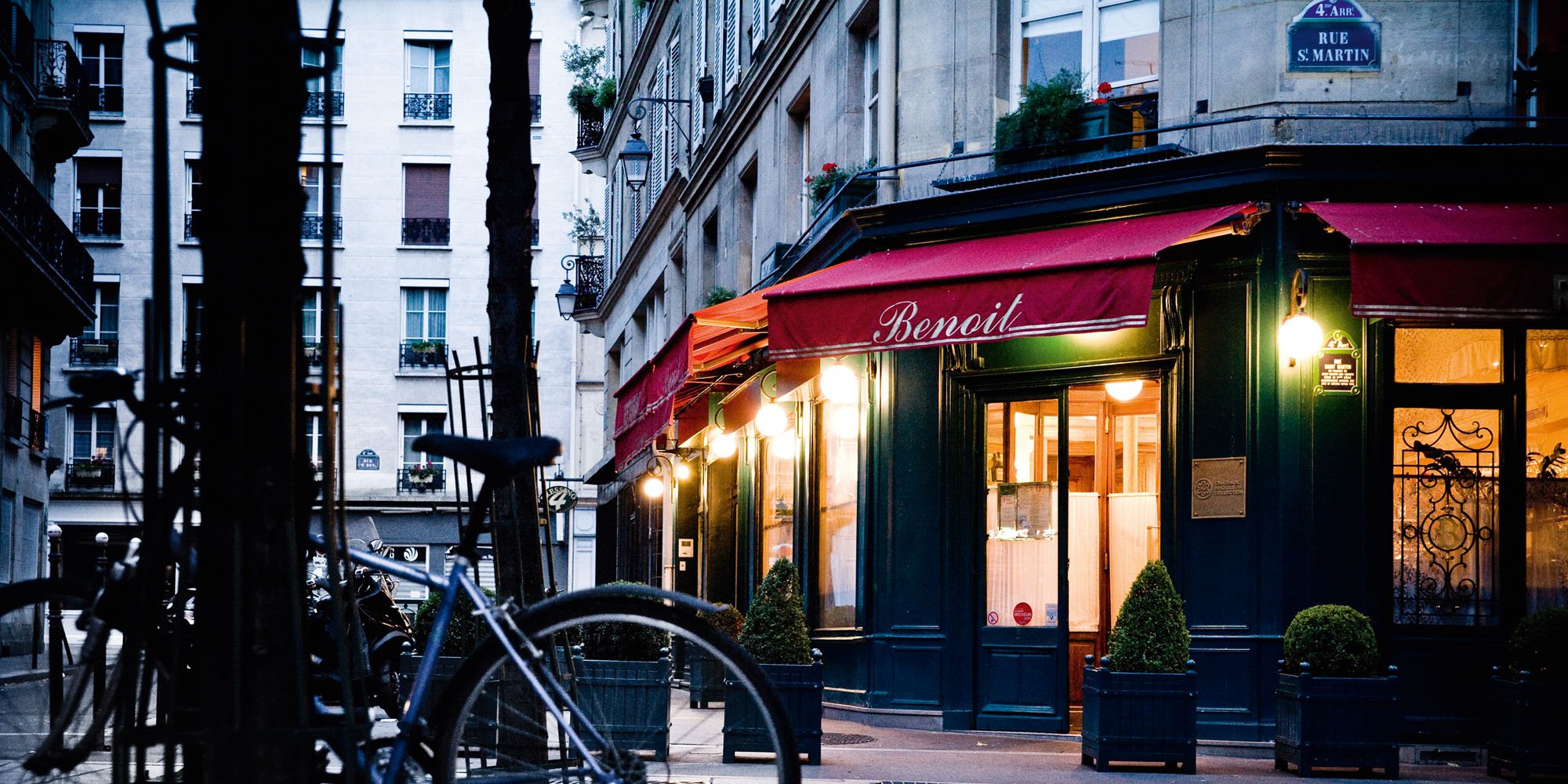 One
hundred and four years ago, a butcher named Benoit
Matray
opened a Paris bistro (left) on the Rue Saint Martin
that bore his name and the promise, “At Benoit,
food and drink just like at home,” which was
quite a compliment to the bourgeois mamans
of the fin
de siècle.
Later on, the words changed to “At Benoit
you eat like a king!” suggesting that this
quintessential bistro, with its carved wood, copper
bar, tiles, red banquettes and engraved glass
went up-market—even more so after Alain Ducasse
bought the place in 2005 from the third
generation of the Matray family.
One
hundred and four years ago, a butcher named Benoit
Matray
opened a Paris bistro (left) on the Rue Saint Martin
that bore his name and the promise, “At Benoit,
food and drink just like at home,” which was
quite a compliment to the bourgeois mamans
of the fin
de siècle.
Later on, the words changed to “At Benoit
you eat like a king!” suggesting that this
quintessential bistro, with its carved wood, copper
bar, tiles, red banquettes and engraved glass
went up-market—even more so after Alain Ducasse
bought the place in 2005 from the third
generation of the Matray family.
Thankfully, one will find that
the original Benoit still has pretty much the same
look and menu it has had since before World War I.
Under Ducasse,
Benoit has sprouted branches in Tokyo,
Osaka, and NYC, where it took over the beloved La
Côte Basque in the spring of 2008. The
Manhattan operation, looking very Parisian indeed,
had its growing pains but eventually settled into
the look and feel of a bistro that has 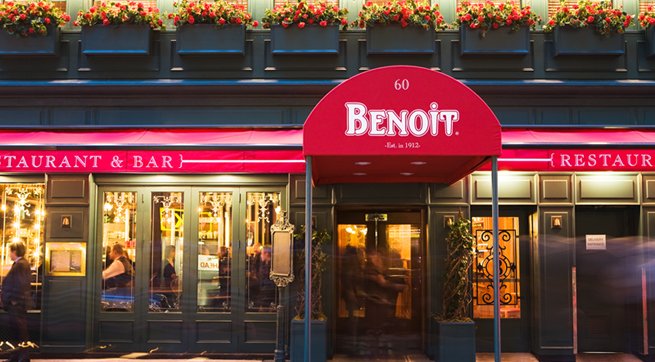 been around for decades. (NYC
has quite a number of venerable old bistros,
including Cherche Midi, Chez Napoleon, La
Mangeoire, and Montmartre, all with similar
menus.)
been around for decades. (NYC
has quite a number of venerable old bistros,
including Cherche Midi, Chez Napoleon, La
Mangeoire, and Montmartre, all with similar
menus.)
Today, as you enter the New
York Benoit (right),
through a revolving door, to your
left is a handsome, jaunty, very popular little
bar, both before and after theater, serving a
light menu and an array of aperitifs. The
large main dining room is done up in golden-blond
wood, tile floors, wall scones, bright
tablecloths, and big mirrors, with enchanting trompe l'œil
cloudy blue sky above you. The good lighting
allows you to see everyone in the
room—neighborhood regulars, theater people and
theater-goers, and real live visitors from France,
as are many of Benoit’s staff.
I’ve been to Benoit often as
it’s evolved, but my most recent visit was
preceded a few weeks prior by one during which
just about everything, from greeting to service to
food, was so lackluster that I thought either the
chef had changed or the staff was on the last week
of their work visas. It was with real relief,
then, that I returned two weeks ago to find
everything as it was at its best.
Perhaps
buoyed
by a very favorable NY Times
review, the staff, now under Guillem Kerambrun
(who also oversees the beverage program), displayed
a buoyant French ésprit and
the food overall had returned to good form. I was,
of course, happy to see Philippe Bertineau still
the chef, after stints at the Hôtel du Palais in
Biarritz, Restaurant Lucien Vanel in
Toulouse, Restaurant Daniel in NYC, Payard
Pâtisserie & Bistro, and, most recently, at
Balthazar.
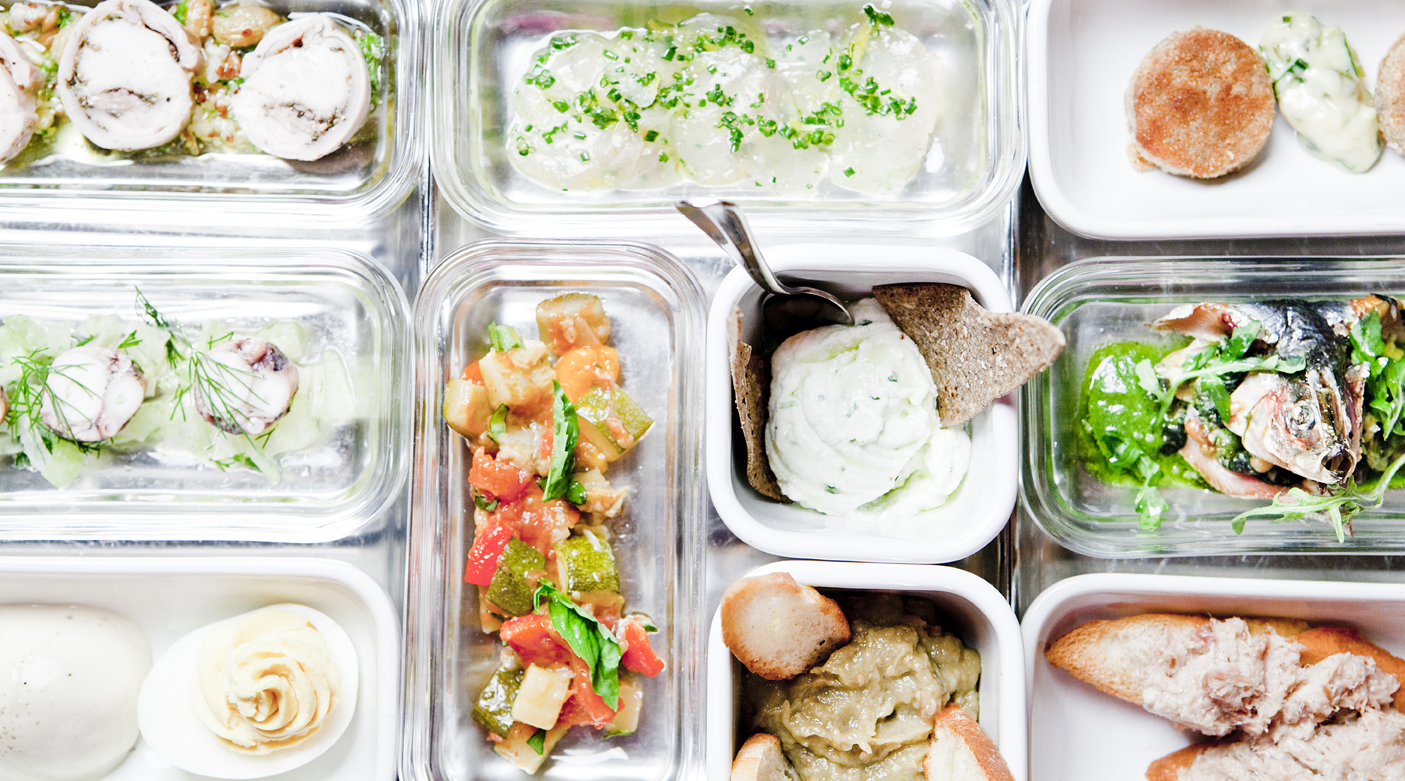 The
menu toes the sacrosanct Parisian line, starting
off with hors d’oeuvres (left) like good and garlicky cod
brandade;
rich and creamy pork rillettes;
and a crisp, fatty pied de
cochon with tartar sauce, and more. A
choice of three ($14) makes for a good starter,
five ($19) just enough to be shared by two people.
The
menu toes the sacrosanct Parisian line, starting
off with hors d’oeuvres (left) like good and garlicky cod
brandade;
rich and creamy pork rillettes;
and a crisp, fatty pied de
cochon with tartar sauce, and more. A
choice of three ($14) makes for a good starter,
five ($19) just enough to be shared by two people.
But first there is the lagniappe of puffy gougères, hot
and
riddled with
Gruyère cheese, along with excellent bread
and butter; brioche toast comes with a starter of
duck foie gras terrine with rhubarb chutney ($28). And
don’t fail to order the Alsatian tart flambé
lavished with abundant sweet onions and smoky
morsels of bacon.
It’s
absurd to think Bertineau would craft anything but
a textbook perfect onion soupe gratinée (below; $14)
or delicious fat escargots swimming in a
garlic-parsley butter ($14). Odd
then that an expensive (at $29) cookpot of lobster
with spelt, chestnut, wild mushrooms and baby kale
could be so lackluster, the lobster overcooked on
two occasions, the sauce bland.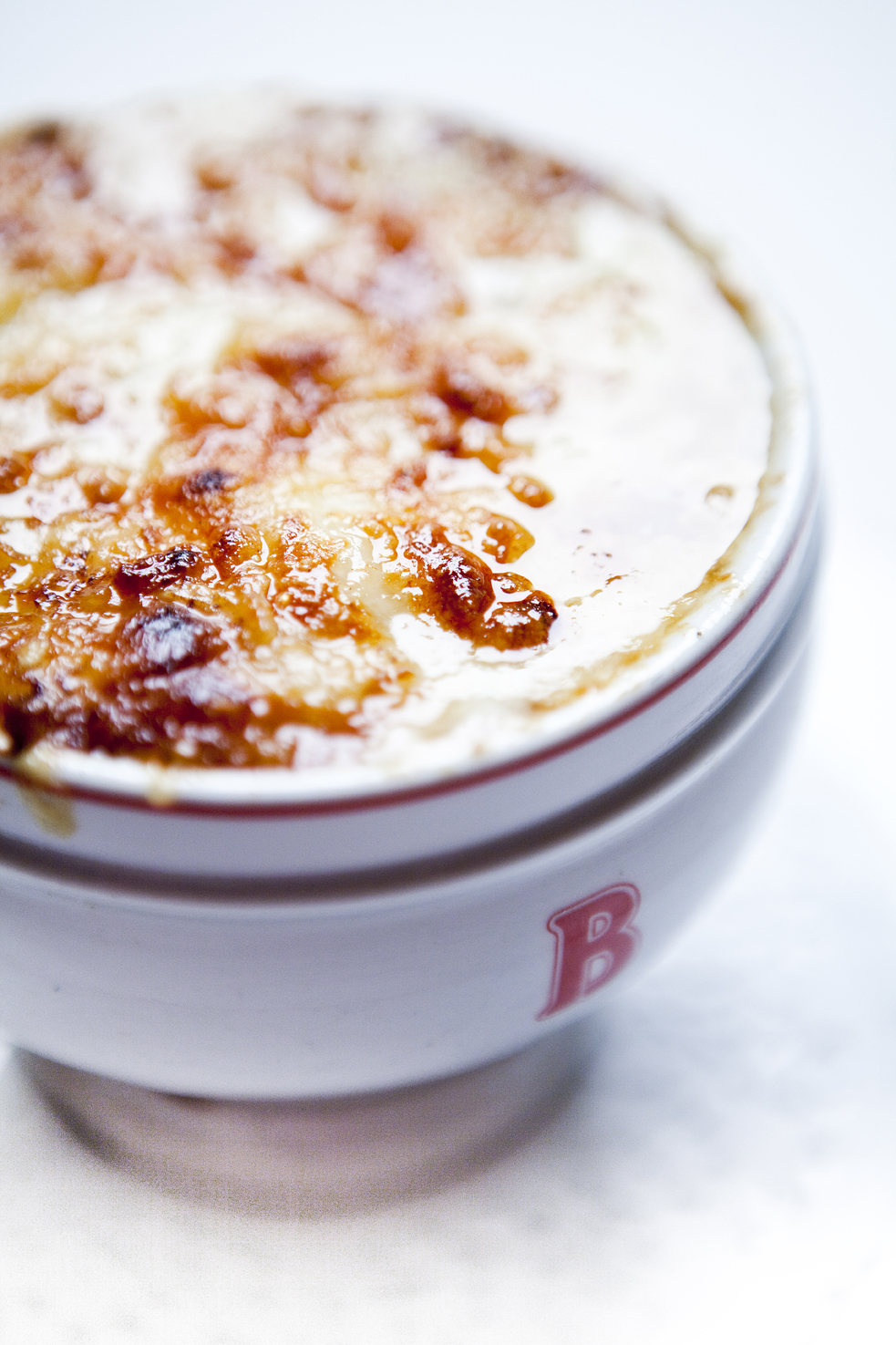
Main courses have been winnowed to a basic
ten items, as in Paris, with daily specials. One of
the consistent favorites here, from the old La
Côte Basque—once removed from Benoit’s menu then
put back after people clamored for it—are the
quenelles of pureed pike with an exceptionally
rich, silky Nantua sauce on fluffy rice pilaf
($28). Of course, there is roast chicken, now
available for one ($27) or two ($52), all very
succulent and buttery and perfumed with rosemary,
though the skin was somewhat flaccid that night,
served with a haystack of piping hot, thin French
fries (which you should order whatever else you
opt for).
Cassoulet ($34)
was hearty enough, but should have had a better,
crackling crust.
The bistro staple of filet mignon was of
very generous size, perfectly cooked outside and
in and ennobled with the classic peppercorn sauce
($46) that makes this less-fatty cut so much more
flavorful. The special of the evening was tender
white halibut, napped in a citrus-flavored
reduction.
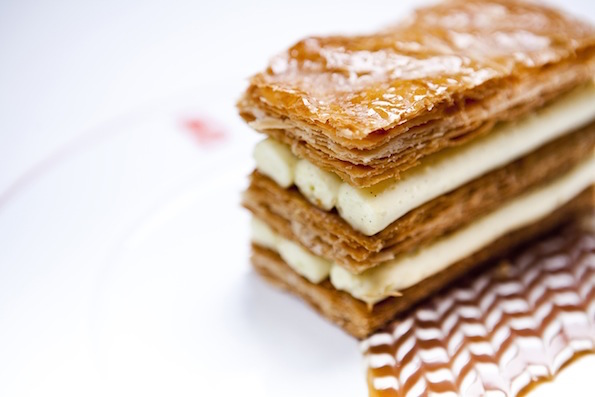 Perhaps it is an
affectation of mine, but among the desserts I
would have enjoyed having the finely grained baba,
laced with excellent Armagnac and whipped cream
($12), to be lighted on fire—it’s fun and doesn’t
hurt the dessert. But Jean-LoupTeterl’s chocolate
soufflé with vanilla ice cream ($12) could not
have been better, and the very fragile vanilla
millefeuille (left;
$12) is possibly the best in NYC and would compete
well with any in Paris.
Perhaps it is an
affectation of mine, but among the desserts I
would have enjoyed having the finely grained baba,
laced with excellent Armagnac and whipped cream
($12), to be lighted on fire—it’s fun and doesn’t
hurt the dessert. But Jean-LoupTeterl’s chocolate
soufflé with vanilla ice cream ($12) could not
have been better, and the very fragile vanilla
millefeuille (left;
$12) is possibly the best in NYC and would compete
well with any in Paris.
Benoit’s wine list is far more extensive
than most bistros even think of having, and there
are some good bottles under $50. By the way, every
Tuesday this month offers Le Cochon ($39),
slow-roasted suckling pig, which is so popular
it’s wise to call in advance.
So
I was made happy again by my return visit, and I
realized that so much of the appeal of Benoit is
its surroundings and its élan, the kind of place
that at its best reminds you of everything there
is to love about French bistros and everything you
come to expect in a city where the best is always
available. And
I hope the entire staff keeps their Green Cards
and stays put here forever.
Benoit is open daily for lunch and
dinner. A la carte, but with special prix
fixe lunch and dinner.
❖❖❖
ALEXANDER VALLEY VINEYARDS
By Geoff Kalish
 Located
about an hour-and-a-half car ride north of the
Golden Gate Bridge, Alexander Valley is the
largest of Sonoma’s designated viticultural
areas. And, while once a prime place for growing
grapes used for jug bottlings, the area is now
home to some of the best producers of U.S. wine. One
of those producers is the Alexander Valley
Vineyards.
Located
about an hour-and-a-half car ride north of the
Golden Gate Bridge, Alexander Valley is the
largest of Sonoma’s designated viticultural
areas. And, while once a prime place for growing
grapes used for jug bottlings, the area is now
home to some of the best producers of U.S. wine. One
of those producers is the Alexander Valley
Vineyards.
Originally part of the homestead of the
valley’s namesake Cyrus Alexander, this property
was purchased in 1962 by Maggie and Harry Wetzel,
who planted and sold premium grapes until 1975,
when they built a winery and began making and
selling their own wine. Today, the third
generation of the Wetzels continues to be active
in the winery with production up to 170,000 cases
a year—about 80% red. And, while their very
popular, easy drinking, fruity Sin Zin ($20) is a
top seller (23,000 cases per year), they make
other top-notch Chardonnays and reds—particularly
Pinot Noir and a red blend called Cyrus.
A Sampling of Recent Releases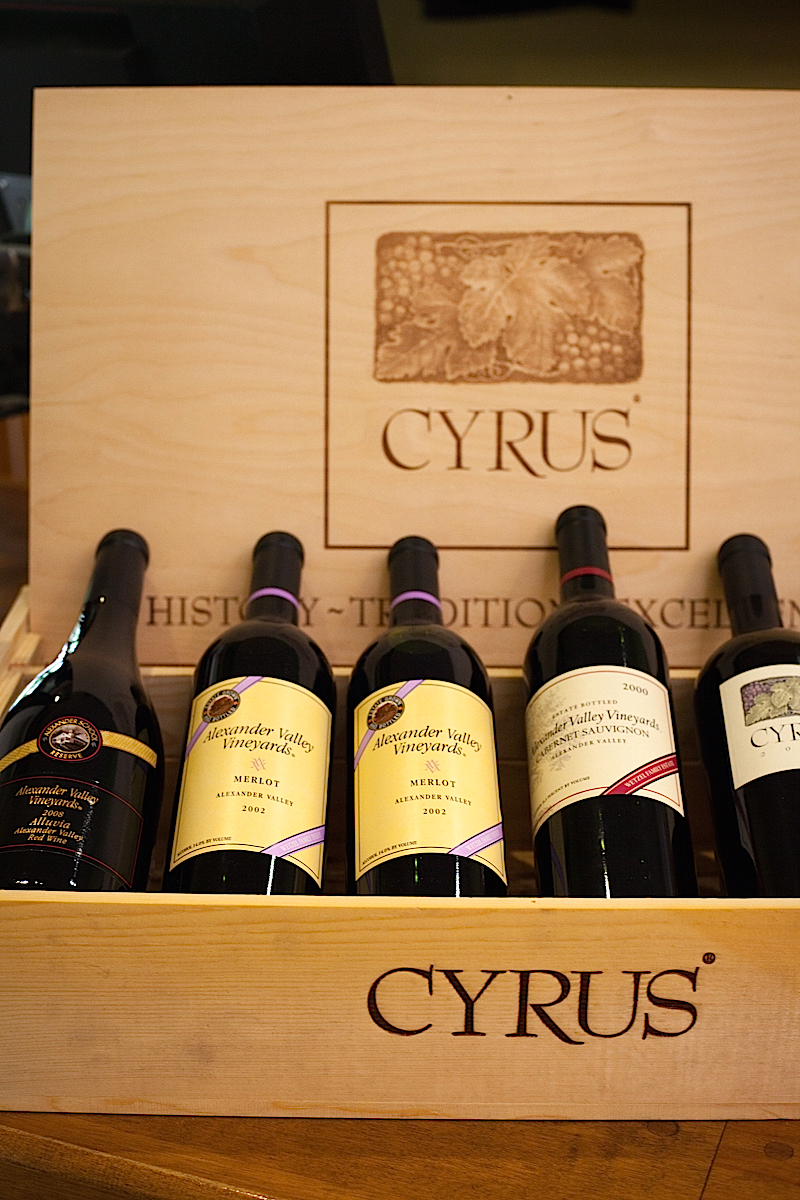
2013
Estate Grown Chardonnay ($28)—This FiftyBest
recent Gold Medal winner showed a bouquet of
lemons and pineapple, with a bright crisp flavor
of apples and pears.
2013
Estate Pinot Noir ($28)—This FiftyBest
Gold Medal winner had a bouquet of dried apricots
and cherries with a taste of currants and plums
with a hint of strawberry in its smooth finish.
2010
Cyrus ($53)—This Bordeaux-like blend of
Cabernet Sauvignon, Merlot, Cabernet Franc, Petit
Verdot and Malbec showed a fragrant bouquet and
taste of cassis and ripe berries with a complex
taste of fruit and oak and a long finish with a
touch of tannin.
Alexander
Valley
Vineyards
8644
California Highway 128, Healdsburg
707 433-7209
www.avvwine.com
Open
for tasting daily 10 a.m.–5 p.m. (except major
holidays). Cave tours are conducted daily at
11a.m. and 2 p.m.
❖❖❖

HOPE SHE
DOESN'T FIND OUT THAT NESTLE
ALSO MAKES
PURINA ALPO DOG CHOW!
ACTUALLY, OUR FIRST TASTE REMINDED
US OF OUR FIRST DAY IN CHEM LAB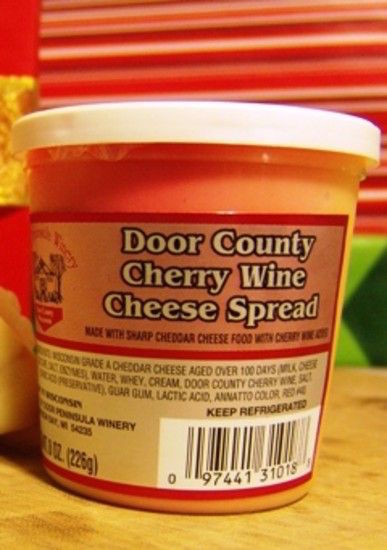
“You may or may not remember
the first time you tried cold pack cheese spread. I
do. I remember it like one remembers a first kiss,
first joint, or first shot of liquor: totally
foreign, slightly confusing, and worth
another taste. What was this stuff, I wondered as I
gazed down into the little plastic tub, one of my
grandma’s stubby cocktail spreaders plunged into
its surface like a flag on the moon.”--“Exploring
Cold Pack Cheese Spread” by
Brett Kell, Edible
Milwaukee (Winter 2016)
Any of John Mariani's books below may be ordered from amazon.com.
 The
Hound in Heaven (21st Century Lion Books) is
a novella, and for anyone who loves dogs, Christmas,
romance, inspiration, even the supernatural, I hope you'll
find this to be a treasured favorite. The
story concerns how, after a New England teacher, his wife
and their two daughters adopt a stray puppy found in their
barn in northern Maine, their lives seem full of promise.
But when tragedy strikes, their wonderful dog Lazarus and
the spirit of Christmas are the only things that may bring
back his master back from the edge of despair.
The
Hound in Heaven (21st Century Lion Books) is
a novella, and for anyone who loves dogs, Christmas,
romance, inspiration, even the supernatural, I hope you'll
find this to be a treasured favorite. The
story concerns how, after a New England teacher, his wife
and their two daughters adopt a stray puppy found in their
barn in northern Maine, their lives seem full of promise.
But when tragedy strikes, their wonderful dog Lazarus and
the spirit of Christmas are the only things that may bring
back his master back from the edge of despair. WATCH THE VIDEO!
“What a huge surprise turn this story took! I was completely stunned! I truly enjoyed this book and its message.” – Actress Ali MacGraw
“He had me at Page One. The amount of heart, human insight, soul searching, and deft literary strength that John Mariani pours into this airtight novella is vertigo-inducing. Perhaps ‘wow’ would be the best comment.” – James Dalessandro, author of Bohemian Heart and 1906.
“John Mariani’s Hound in Heaven starts with a well-painted portrayal of an American family, along with the requisite dog. A surprise event flips the action of the novel and captures us for a voyage leading to a hopeful and heart-warming message. A page turning, one sitting read, it’s the perfect antidote for the winter and promotion of holiday celebration.” – Ann Pearlman, author of The Christmas Cookie Club and A Gift for my Sister.
“John Mariani’s concise, achingly beautiful novella pulls a literary rabbit out of a hat – a mash-up of the cosmic and the intimate, the tragic and the heart-warming – a Christmas tale for all ages, and all faiths. Read it to your children, read it to yourself… but read it. Early and often. Highly recommended.” – Jay Bonansinga, New York Times bestselling author of Pinkerton’s War, The Sinking of The Eastland, and The Walking Dead: The Road To Woodbury.
“Amazing things happen when you open your heart to an animal. The Hound in Heaven delivers a powerful story of healing that is forged in the spiritual relationship between a man and his best friend. The book brings a message of hope that can enrich our images of family, love, and loss.” – Dr. Barbara Royal, author of The Royal Treatment.
 |
The Encyclopedia of American Food and Drink by John F. Mariani (Bloomsbury USA, $35) Modesty forbids me to praise my own new book, but let me proudly say that it is an extensive revision of the 4th edition that appeared more than a decade ago, before locavores, molecular cuisine, modernist cuisine, the Food Network and so much more, now included. Word origins have been completely updated, as have per capita consumption and production stats. Most important, for the first time since publication in the 1980s, the book includes more than 100 biographies of Americans who have changed the way we cook, eat and drink -- from Fannie Farmer and Julia Child to Robert Mondavi and Thomas Keller. "This book is amazing! It has entries for everything from `abalone' to `zwieback,' plus more than 500 recipes for classic American dishes and drinks."--Devra First, The Boston Globe. "Much needed in any kitchen library."--Bon Appetit. |
"Eating Italian will never be the same after reading John Mariani's entertaining and savory gastronomical history of the cuisine of Italy and how it won over appetites worldwide. . . . This book is such a tasteful narrative that it will literally make you hungry for Italian food and arouse your appetite for gastronomical history."--Don Oldenburg, USA Today. "Italian
restaurants--some good, some glitzy--far
outnumber their French rivals. Many of
these establishments are zestfully described
in How Italian Food Conquered the World, an
entertaining and fact-filled chronicle by
food-and-wine correspondent John F.
Mariani."--Aram Bakshian Jr., Wall Street
Journal.
"Equal parts
history, sociology, gastronomy, and just
plain fun, How Italian Food Conquered the
World tells the captivating and delicious
story of the (let's face it) everybody's
favorite cuisine with clarity, verve and
more than one surprise."--Colman Andrews,
editorial director of The Daily
Meal.com. "A fantastic and fascinating
read, covering everything from the influence
of Venice's spice trade to the impact of
Italian immigrants in America and the
evolution of alta cucina. This book will
serve as a terrific resource to anyone
interested in the real story of Italian
food."--Mary Ann Esposito, host of PBS-TV's
Ciao
Italia. "John Mariani has written the
definitive history of how Italians won their
way into our hearts, minds, and
stomachs. It's a story of pleasure over
pomp and taste over technique."--Danny Meyer,
owner of NYC restaurants Union Square
Cafe, The Modern, and Maialino.
|
 |
 |
 |
 |
 |
 |
 |
 |
 Everett Potter's Travel Report:
Everett Potter's Travel Report: 
 Eating Las Vegas
JOHN CURTAS has been covering the Las Vegas
food and restaurant scene since 1995. He is
the co-author of EATING LAS VEGAS – The 50
Essential Restaurants (the fourth
edition of which will be published in early
2016), as well as the author of the Eating Las
Vegas web site: www.eatinglasvegas.
He can also be seen every Friday morning as
the “resident foodie” for Wake Up With the
Wagners on KSNV TV (NBC) Channel 3 in
Las Vegas.
Eating Las Vegas
JOHN CURTAS has been covering the Las Vegas
food and restaurant scene since 1995. He is
the co-author of EATING LAS VEGAS – The 50
Essential Restaurants (the fourth
edition of which will be published in early
2016), as well as the author of the Eating Las
Vegas web site: www.eatinglasvegas.
He can also be seen every Friday morning as
the “resident foodie” for Wake Up With the
Wagners on KSNV TV (NBC) Channel 3 in
Las Vegas.

MARIANI'S VIRTUAL GOURMET
NEWSLETTER is published weekly. Editor/Publisher: John
Mariani.
Editor: Walter Bagley. Contributing Writers: Christopher Mariani,
Robert Mariani, Misha
Mariani,
John A. Curtas, Edward Brivio, Mort Hochstein,
Andrew Chalk, Dotty Griffith and Brian Freedman. Contributing
Photographers: Galina Dargery, Bobby
Pirillo. Technical Advisor: Gerry McLoughlin.
To un-subscribe from this newsletter,click here.
© copyright John Mariani 2016

